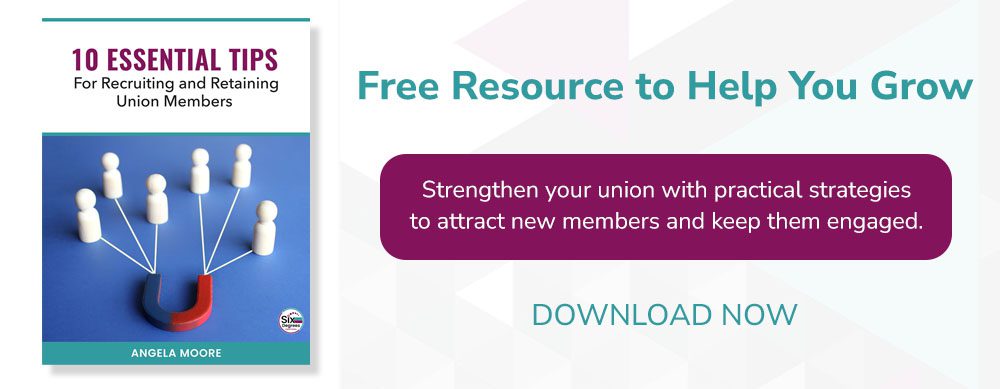In the fast-paced world of digital marketing, unions face unique challenges that can make online strategies feel overwhelming. With a rich history rooted in strong community ties and collective action, unions must find ways to translate these foundational principles into effective online strategies. This often means cutting through the digital noise to connect with both current and potential members in meaningful ways.
In this article, we’ll explore a customized approach that honors the essence of union values while embracing the latest in digital marketing techniques. From crafting a compelling online presence to mastering content marketing across various platforms, we’ll go over actionable strategies and best practices specifically designed for unions.
Whether you’re looking to revamp your current efforts or starting from scratch, these insights will help you forge stronger connections and boost engagement in the digital realm. Let’s turn those digital challenges into opportunities for growth and connection.
Building a Strong Online Presence
In today’s digital-first environment, the cornerstone of any successful outreach strategy is a well-designed website. For unions, this is particularly crucial. A robust online presence not only communicates your values and mission effectively but also serves as the central hub for member engagement and information dissemination. It’s the virtual handshake that introduces your union to potential new members and re-engages existing ones.
Here are some practical tips for ensuring your website is not just functional but a dynamic tool in your digital arsenal:
- User-Friendly Design: Ensure your website is easy to navigate with a clean, intuitive design. Members should find what they need (contact information, event calendars, resources) without any hassle. Think of your website’s design as the digital equivalent of an open-door policy.
- Regular Updates:A stagnant website can give the impression of a stagnant organization. Regular updates keep content fresh and demonstrate an active, vibrant community. This could be anything from news on recent union activities, upcoming events, or spotlight features on members making a difference.
- Responsive and Accessible: With the increasing use of mobile devices to access the internet, ensure your website is responsive and can be easily viewed on various devices. Additionally, accessibility should be a priority—ensure that members with disabilities can also interact with your online content without barriers.
- Secure and Private: Ensure that your website adheres to the latest security protocols to protect sensitive member information. Trust is paramount, and a secure site is a trust-building tool.
- Engagement Tools: Incorporate features such as forums, polls, or live chat options to keep members engaged and feedback-oriented. These tools not only keep the conversation going but also build a community feeling among members.
A strong online presence solidifies your union’s credibility and enhances its reach. By keeping these tips in mind, you can turn your union’s website into a powerful engagement hub that resonates well with both current and prospective members, fostering a deeper connection with the community you serve.
Content Marketing Strategies for Unions
When it comes to engaging union members and potential recruits, content is not just king—it’s the crucial communicator of your union’s values, achievements, and news. Understanding the types of content that resonate with your audience can significantly enhance member engagement and help in recruiting efforts.
Types of Content That Resonate with Union Members:
- Success Stories and Case Studies: Members love to hear about victories, whether they are improvements in working conditions, successful negotiations, or spotlight stories on members who have made significant contributions. These narratives not only inspire but also strengthen communal ties.
- Educational Content: Informative articles or videos about rights, training opportunities, and industry updates are invaluable. They empower members through knowledge, helping them make informed decisions and stay ahead in their fields.
- Newsletters: Regular newsletters help keep members informed about union activities, news, and more. It’s a direct line to your audience that says you value their involvement and wish to keep them informed.
Best Practices for Content Creation and Distribution:
- Understand Your Audience: Tailor your content to the interests and needs of your members. Use language that is inclusive and resonant with the collective spirit of the union.
- Consistency is Key: Regularly scheduled content keeps members engaged and informed. Establish a consistent publishing schedule that members can rely on.
- Multichannel Distribution: Share your content across multiple platforms where your members are most active, whether that’s email, social media, or your union’s website. This multi-touch approach helps reinforce your message and increases engagement.
- Engage with Feedback: Encourage members to interact with your content through comments or sharing their own stories. Engagement isn’t just about broadcasting; it’s about starting conversations and building community.
- Monitor and Adapt: Use analytics tools to track the performance of your content. See what resonates with your audience and adapt your strategy accordingly to better meet their needs.
By crafting meaningful content tailored to the interests and needs of union members, and distributing it effectively across multiple channels, you create opportunities for deeper connections and ongoing engagement. Remember, every piece of content is an opportunity to reinforce trust and underscore the value of union membership.
Social Media Marketing for Unions
Social media offers unions a powerful tool to connect, communicate, and mobilize members. However, the effectiveness of your social media strategy hinges on choosing the right platforms and engaging content that resonates with your audience.
Choosing the Right Platforms:
Not all social platforms cater to the same demographics, so understanding where your members spend their digital time is crucial. For most unions, platforms like Facebook and LinkedIn are staples because they support expansive networks and facilitate direct communication. For visual storytelling, Instagram and YouTube can be effective in showcasing the human side of union activities and member involvement.
Strategies for Engaging and Growing Your Social Media Presence:
- Authenticity Wins: Share real stories from real members. Authentic content builds trust and strengthens community ties more than polished ads ever could.
- Interactive Content: Use polls, surveys, and question-based posts to engage your audience actively. These tools not only stimulate interaction but also provide insights into your members’ opinions and needs.
- Regular Updates: Keep your community informed with regular updates about union news, upcoming events, and important advocacy information. Consistency keeps your audience engaged and informed.
- Video Content: Video content has high engagement rates. Consider live broadcasts of meetings or short videos explaining union benefits which can demystify union operations and draw in a broader audience.
- Monitor Engagement: Keep an eye on what types of posts generate the most engagement. Analytics can offer invaluable insights into member interests and help refine your strategy.
- Hashtags: Create unique hashtags for campaigns or general union branding which can increase visibility and discoverability across social media platforms.
By strategically selecting the right platforms and crafting engaging, authentic content, unions can effectively enhance their social media presence. This not only strengthens existing member relations but also attracts potential new members who see the active role the union plays in advocating for its community. Remember, social media is not just a broadcasting tool—it’s a conversation that invites both listening and speaking.
Email Marketing Techniques for Unions
Email remains one of the most direct and personal forms of communication, making it a vital tool for union communications and member engagement. Developing a structured email marketing strategy can greatly enhance your ability to communicate effectively with your members.
Building and Segmenting Your Email List:
The first step to an effective email campaign is building a comprehensive email list. Ensure every member is given an opportunity to subscribe, possibly during membership registration or events. Once you have your list, segmentation is crucial. Group members by criteria such as occupation, location, or interests. This allows for targeted communications that are relevant to each subgroup, increasing engagement and reducing unsubscribe rates.
Crafting Impactful Email Campaigns:
- Personalization: Use the data from your segmentation to personalize emails. Addressing members by name and referencing their specific interests or sector can significantly increase open rates and engagement.
- Clear and Concise Content: Keep your messages straightforward and to the point. Busy members will appreciate emails that respect their time and quickly convey the necessary information.
- Strong Call to Actions (CTAs): Every email should have a clear purpose, whether it’s encouraging members to attend a meeting, participate in a vote, or support a cause. Make sure your CTAs are prominent and compelling.
- Consistent Schedule: Regular but not overwhelming—determine an email cadence that keeps members informed but not inundated. Consistency builds expectation and trust.
- Test and Optimize: Utilize A/B testing on subject lines, content formats, and CTAs to see what resonates best with your segments. Use these insights to continually refine your approach.
- Responsive Design: Ensure your emails look good on both desktops and mobile devices. Many people check their emails on-the-go, so mobile optimization is not optional.
Effective email marketing helps keep union members informed, engaged, and active. By responsibly managing your email list and crafting thoughtful, targeted campaigns that speak directly to the needs and interests of your audience, you set the stage for deeper involvement and stronger union solidarity. Remember, each email is an opportunity to reinforce the value of their membership and the collective strength of the union.
SEO and Local Search Optimization for Unions
In the digital age, search engine optimization (SEO) is a crucial tool for making your union visible to both existing and potential members. Integrating basic SEO techniques can significantly boost your online presence, while focusing on local SEO ensures you connect with members and supporters in your specific area.
Basic SEO Techniques to Improve Visibility:
- Keywords: Identify keywords that are relevant to your members and the services you provide. Incorporate these terms naturally into your website’s content, blog posts, and even in your social media to improve search rankings.
- Quality Content: Regularly update your site with high-quality, relevant content. This could include blog posts about recent union activities, benefits of joining the union, or important updates affecting the sector.
- Mobile Optimization: Ensure your website is mobile-friendly. With more people accessing information via smartphones, a responsive design is essential for good SEO.
- Meta Descriptions and Tags: Use clear meta descriptions for your web pages. These are the brief previews that appear under your page title on search engines and can influence whether someone clicks on your link.
Importance of Local SEO for Unions:
Local SEO is particularly important for unions because it allows you to target potential members in specific geographic areas. Here’s how you can optimize locally:
- Google My Business: Register your union with Google My Business. This makes it easier for people to find information about your location, contact details, and operating hours.
- Local Keywords: Use geo-specific keywords in your content. For example, if your union is based in Chicago, include references to “Chicago,” “Illinois,” or even specific neighborhoods.
- Local Listings: Ensure your union is listed in local online directories. Consistency in your listings (name, address, phone number) boosts your local search rankings.
- Community Engagement Content: Create content that highlights your involvement with local issues and events, which can elevate relevance in local search results.
Optimizing both general and local SEO can dramatically increase your visibility online, making it easier for current members to stay informed and for potential members to discover you. Remember, the goal of SEO isn’t just about getting found—it’s about being found by the right people at the right time when they need the support and community that your union offers.
Leveraging Analytics to Measure Success
In the dynamic world of digital marketing, understanding the impact of your efforts is crucial. Leveraging analytics not only shows you what’s working but also what can be improved. For unions, where resources can be limited, ensuring that every dollar spent on digital marketing counts is vital.
Tools and Metrics for Tracking Digital Marketing Performance:
- Google Analytics: This tool is indispensable for tracking website traffic, user behavior, and engagement levels. It helps you understand how visitors interact with your site and which pages capture their attention.
- Social Media Analytics: Platforms provide in-depth insights into post performance, audience demographics, and engagement rates. This data is key to refining your social media strategy.
- Email Marketing Software: Tools such as Mailchimp or Constant Contact offer analytics on open rates, click-through rates, and conversions from email campaigns. This is crucial for understanding how your communications are received by members.
Adjusting Strategies Based on Data Insights:
Data-driven decisions can significantly enhance your marketing effectiveness. For instance, if website analytics reveal high bounce rates on specific pages, it might indicate that content needs to be more engaging or accessible. Similarly, low engagement on social media posts might prompt a review of the type of content you publish or the times you post.
Using these insights, you can refine your strategies continuously to ensure they remain effective and responsive to your members’ needs.
Moving Forward
Digital marketing for unions involves a multifaceted approach; from building a strong online presence with a well-designed website to engaging members through targeted email campaigns and robust social media strategies. Remember, the key is to maintain clarity in communication, authenticity in messaging, and regularity in engagement.
Utilizing SEO effectively will ensure that the right people find you at the right time, while leveraging analytics allows for the fine-tuning of strategies based on actual data, not just gut feelings.
If this sounds overwhelming, remember: you don’t have to navigate this digital landscape alone. Consider scheduling a free strategy session with us. We’re here to help streamline your digital marketing efforts and strengthen your union’s online presence. Let’s work together to make every digital interaction impactful.






